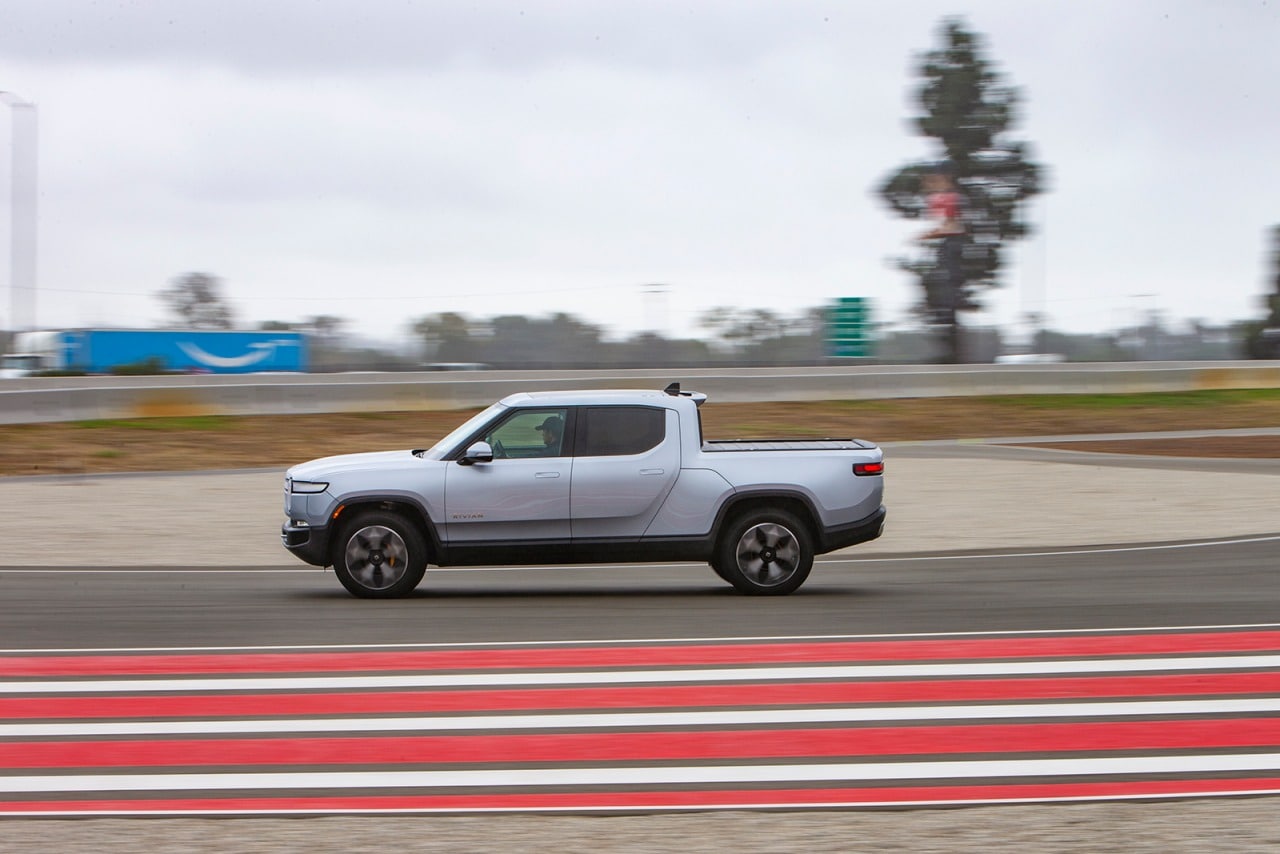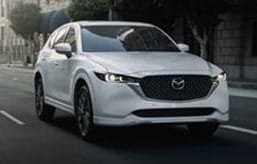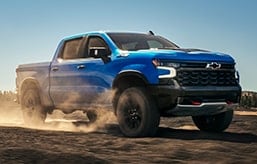- The 2022 Rivian R1T covered 317 miles on Edmunds' real-world EV range loop, hitting its EPA-estimated range of 314 miles with 3 miles to spare.
- The R1T is also the least efficient EV we've tested by far, meaning it needed a whole lot of electricity to cover those miles.
- Even so, all that electricity is cheaper — potentially a lot cheaper — than the gasoline or diesel required to power a conventional truck.
REAL-WORLD TEST: 2022 Rivian R1T Beats EPA Range by 3 Miles, but With Epic Inefficiency
The 2022 Rivian R1T is the first of the new EV trucks to arrive, and we got our hands on an R1T Launch Edition, which comes standard with a 135-kilowatt-hour battery pack that can power the truck for 314 miles, according to the EPA. This battery is actually second in size to Rivian's optional $10K Max pack, a 180-kWh battery providing over 400 miles of estimated range. Eventually, there will also be a smaller 105-kWh battery pack that will cost less and offer a range in the ballpark of 230 miles.
Am I Ready for an EV?
- EV ownership works best if you can charge (240V) at home or at work
- If you can’t charge at home, charging at a charging station could take at least 10x longer than at a gas station
- Adding a 240V home charging system could cost up to $1,600 or more
Our R1T Launch Edition had the standard 21-inch wheels and all-season tires, and we ran it in Conserve mode, which makes it primarily a front-drive vehicle and lowers the ride height at freeway cruising speeds for better aero efficiency. Full disclosure here: Because of our short loan window, we had to run our real-world test overnight, which meant we were operating completely in the dark, in slightly colder temperatures than usual but with much lighter traffic.
Here's how the Rivian fared.
Testing the Rivian R1T in the real world
Edmunds tests every new electric vehicle on the same real-world driving loop to see just how far it can travel from a full charge down to zero miles remaining. If you scroll through our EV range leaderboard, you'll see that most EVs have matched or exceeded their EPA range estimates in our testing. Much of that has to do with our ability to test in near-ideal conditions year-round, even if — as in the Rivian's case — that means driving through the night.
Notably, all of the initial Rivian R1T models come standard with four electric motors that produce a combined output of 835 horsepower and 908 lb-ft of torque. Add a hefty battery pack to that equation and you can start to understand our R1T's jaw-dropping measured weight of 7,148 pounds without a driver aboard. That's a full ton more than a typically equipped full-size truck weighs, and the Rivian isn't even quite full-size, sitting in between that segment and the midsize group.
Over the course of a semi-sleepy eight-hour stint at the R1T's helm, the average temperature was a chilly 53 degrees, which is the coldest average testing temperature we've recorded for a vehicle to date. The next coldest was during our testing of the Mustang Mach-E California Route 1 at 58 degrees. As a reminder, we keep the climate control set to 72 degrees in every vehicle.
At the end of our all-nighter, we had traveled a total of 317 miles. That's 1% better than its EPA estimate of 314 miles — a thinner margin than we're used to seeing for most EVs, with the exception of Tesla.
Overall, the Rivian's range performance puts it in sixth place on our leaderboard, tied with the Tesla Model Y Long Range, which actually has a slightly higher EPA-estimated range of 326 miles.
So how much did those 317 miles cost?
While the total range of a vehicle continues to dominate the EV conversation, energy consumption is an important factor as well. In Rivian's case, it may be even more important, as the R1T is by far the least efficient EV we've tested yet. Energy consumption is what determines how much your miles will cost you. The unit of measurement for consumption, the kilowatt-hour, can be thought of as the EV equivalent of a gallon of gasoline. Just like gas, the price of electricity varies depending on where you live. For example, you'll pay about 10 cents per kilowatt-hour in Washington as of this writing, whereas in Hawaii it'll run you about 33 cents.
So, what can 2022 Rivian R1T owners expect to pay at "the pump"? After charging the battery back to full, which took about 23 hours and 30 minutes on our Level 2 charger, we calculated an Edmunds consumption rate of 46.9 kWh/100 miles, which is 2.3% more efficient than the EPA estimate of 48 kWh/100 miles. If we lived in Hawaii, our 317-mile trip in the R1T would have cost us $49.06, while if we lived in Washington, that same trip would cost just $14.87.
On the one hand, that's still a good deal compared to what typical trucks cost to refuel — a phenomenal deal on the lower end in Washington. But on the other hand, the Rivian's Edmunds consumption rate of 46.9 kWh/100 miles means it uses nearly 23% more energy per 100 miles than the next most power-hungry EV we've tested, the Audi e-tron Sportback, which clocked in at 38.2 kWh/100 miles. Considering that these two EVs cost about the same, here's how they would compare. That same 317 miles in the e-tron would have cost $39.96 in Hawaii and $12.11 in Washington. So you'd save yourself about $10 a "tank" with the e-tron in Hawaii, though you probably wouldn't notice the difference in Washington.
How about a gasoline-powered equivalent? Well, since the Rivian weighs as much as a heavy-duty truck but can outrun and out-handle even the smallest and nimblest of compact trucks, we're just going to stick with the crazy Ram 1500 TRX for this comparison. The TRX requires premium fuel and is estimated to return a laughable 12 mpg in combined driving. So driving it for 317 miles would have set us back $126.01 in Hawaii ($4.77 per gallon) and $112.54 in Washington ($4.26 per gallon) at current prices, assuming we got the TRX's 12 mpg combined.
Based on these numbers, you could save an estimated $2,714 per year in Hawaii and a whopping $3,168 per year in Washington by driving a Rivian R1T for 10,000 miles a year instead of the Hellcat-powered Ram. Not to mention, you'd still be faster than the TRX in nearly every scenario ("objects in the mirror are getting farther and farther away").
For more information on how we test EV range and how each vehicle performed, we invite you to visit our Real World vs. EPA testing page, which includes both our EV range leaderboard and a table with detailed test results. Our EV range leaderboard is embeddable and will automatically update every time we add a new vehicle.
Edmunds says
Although the 2022 Rivian R1T is the least efficient EV we've tested to date, it's still a lot cheaper to run than its closest gasoline-powered equivalent — indeed, cheaper than many or most mainstream gasoline vehicles, particularly in areas where electricity is cheap. It also makes good on its EPA range estimate in the real world, albeit by a razor-thin margin. For our latest comprehensive ratings of all electric vehicles, head over to Edmunds' EV rankings page.



 by
by